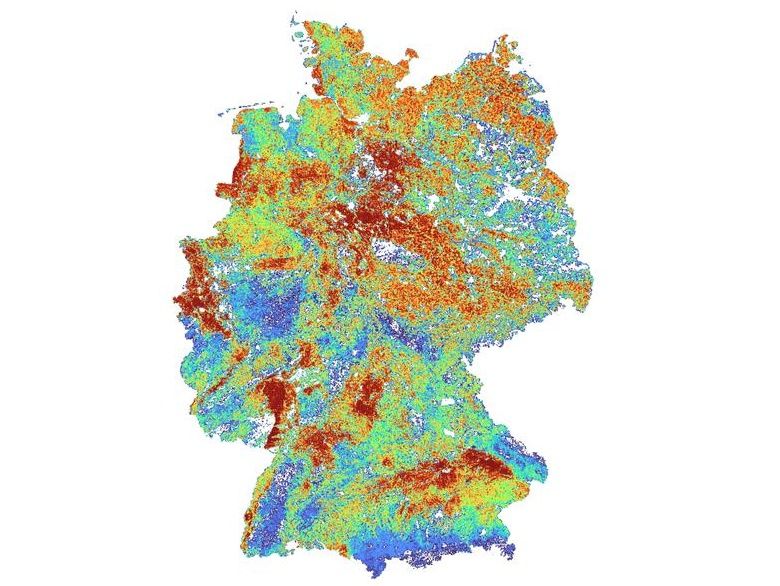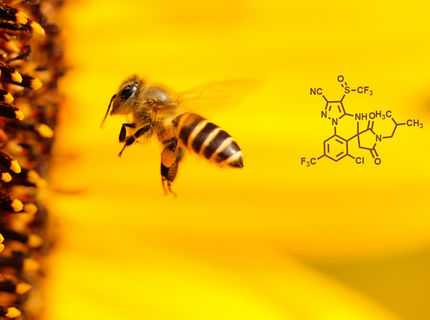Study on the toxicity of pesticides in Germany sees need for action
Pesticide risks in Germany have changed significantly over the past 25 years, as scientists from the Rhineland-Palatinate Technical University Kaiserslautern-Landau (RPTU) report in a recently published study. The risks for terrestrial vertebrates decreased during this time, but those for fish, terrestrial plants and soil organisms increased at the same time. There was no clear trend for other groups of organisms. According to the research team, these findings are particularly important in light of the European Union's (EU) plan to reduce pesticide risks by 50 percent by 2030.

Pesticide risks for pollinators in Germany
Grafik: RPTU, Sascha Bub, 2023
If the countries of the EU want to achieve the target, action must be taken: "To reduce pesticide risks at the national or continental level, it is possible, for example, to use lower amounts of pesticides or to replace a constant amount with less toxic pesticides," Sascha Bub, lead author of the study, explains its basic assumption. Based on this assumption, the Landau researchers have developed a simple method for risk assessment: "If, for each pesticide used in a country in a given year, its applied quantity and its toxicity are multiplied together and the multiplication products are then added up, a rough indicator of how pesticide risks develop is obtained repeatedly over several years. We call this indicator 'total applied toxicity,'" Bub explains. The specific toxicity of pesticides to different groups of organisms varies widely, sometimes by a factor of billions. Some pesticides are particularly toxic to pollinators, while others are toxic to soil organisms or plants. The authors of the study therefore calculated the total toxicity of 292 pesticides applied in Germany between 1995 and 2019 separately for eight organism groups, using 1889 threshold values from the EU approval procedure for pesticides.
The result: in Germany, total toxicity applied has decreased over the past 25 years only for terrestrial vertebrates, while it increased at the same time for fish, terrestrial plants and soil organisms. "The increase in soil organisms deserves attention because they are instrumental in maintaining soil quality. Increasing risks to soil organisms could also have a long-term impact on agricultural productivity," Bub said. The increase in fish is also noteworthy, he said, because there have been strong efforts for many years to reduce the toxicity of pesticides to vertebrates, including fish, and a corresponding decreasing trend had also been shown in a previous study for the United States.
Methods for assessing risk reduction need to be improved
The study also discusses its findings in relation to the EU regulation on the sustainable use of pesticides. This calls for a 50 percent reduction in pesticide risks by 2030. "Any risk reduction target needs indicators to assess its success," notes Ralf Schulz, co-author of the study. "We compared the EU harmonized risk indicator with total applied toxicity to understand why the EU risk indicator shows a decreasing risk, contrary to our results." The scientists complain that the EU risk indicator does not distinguish between different groups of organisms and assigns individual pesticides to fixed risk categories instead of considering their specific toxicity to individual groups of organisms. In the view of the Landau scientists, the EU indicator is therefore unsuitable as a risk indicator. "The application of the harmonized risk indicator does not take into account an essential factor for pesticide risks, namely toxicity," Schulz emphasizes. This indicator did not reflect the fact that some pesticides are increasingly toxic to individual groups of organisms. Moreover, it is designed in a way, Schulz says, that means a mere re-categorization of pesticides can already lead to a declining trend. "The EU has set ambitious pesticide risk reduction targets. The methods used to monitor the achievement of these targets should be as robust as possible."
Note: This article has been translated using a computer system without human intervention. LUMITOS offers these automatic translations to present a wider range of current news. Since this article has been translated with automatic translation, it is possible that it contains errors in vocabulary, syntax or grammar. The original article in German can be found here.
Most read news
Other news from the department science

Get the food & beverage industry in your inbox
By submitting this form you agree that LUMITOS AG will send you the newsletter(s) selected above by email. Your data will not be passed on to third parties. Your data will be stored and processed in accordance with our data protection regulations. LUMITOS may contact you by email for the purpose of advertising or market and opinion surveys. You can revoke your consent at any time without giving reasons to LUMITOS AG, Ernst-Augustin-Str. 2, 12489 Berlin, Germany or by e-mail at revoke@lumitos.com with effect for the future. In addition, each email contains a link to unsubscribe from the corresponding newsletter.


























































